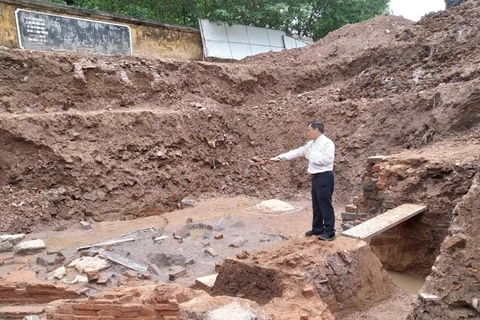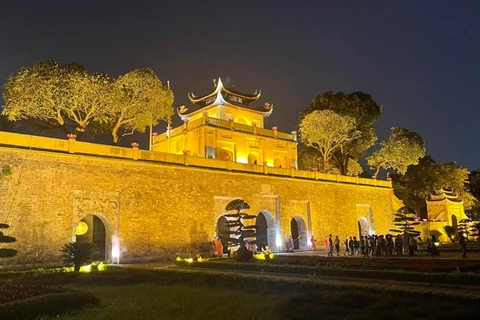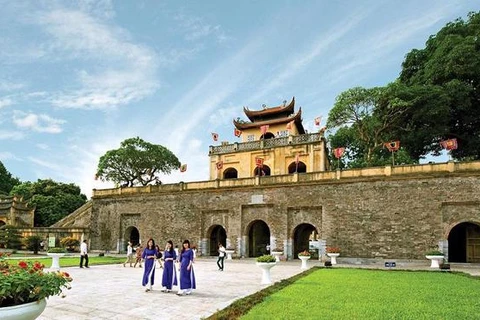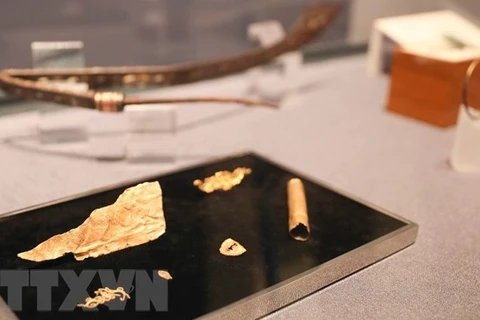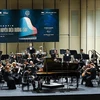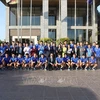Hanoi (VNA) – Experts are working hard together to restore Kinh Thien Palace in the Thang Long Imperial Citadel in Hanoi with an aim to preserve the value of the historical relic site.
According to Associate Professor Nguyen Quang Ngoc, Vice Chairman of the Vietnam Association of Historical Sciences, traces of Kinh Thien Palace, the “heart” of the Thang Long Imperial Citadel are only seen in stone steps. He stressed the urgent need to conduct the restoration of the heritage.
“We have been indebted to our ancestors, to this world heritage for too long," said Ngoc.
Restoring Kinh Thien palace over 10 years
Ngoc is among many scientists who have expressed deep concerns about the restoration of the palace, which has been discussed for many years ago but has still not been carried out.
The wish of Prof. Ngoc is also the aspiration of scientists who are interested in the Imperial Citadel of Thang Long.
At an international workshop to review 20 years of researching, preserving and promoting the heritage value of the Imperial Citadel of Thang Long-Hanoi which took place on September 8-9, the restoration of the palace was discussed. The workshop saw teams contributing to realising the dream of restoring the most important architecture of the Imperial Citadel.
According to Prof. Ngoc, the position of the palace was kept almost unchanged in its 1,000-year history. Even under the Nguyen Dynasty, Kinh Thien Palace served as a place for the King to reside when he was present in the north of Vietnam.
According to Dai Viet Su Ky Toan Thu (Complete Annals of Dai Viet), the palace was built in 1428 under the reign of King Le Thai To (1428-33) and completed in the reign of King Le Thanh Tong (1442-97).
During the French colonial period, the colonialists demolished the Palace and built an artillery headquarters there. The building was then called the Dragon House as its front and back had the statues of stone dragons.
Presently, the remaining vestige of the ancient palace in the Imperial Citadel of Thang Long is its base.
Ngoc underlined that with the current rate of excavation, it will take another hundred years to complete the archeology of the Imperial Citadel. Therefore, Ngoc suggested that it is not necessary to wait until excavation is completed to start the restoration activity. He said the work should be carried out immediately based on the newly obtained excavation results.
Agreeing with Ngoc, Dr. Nguyen Van Son from the Hanoi Association of Historical Sciences said that the restoration of the palace’s space is an urgent need with significant meaning not only for Hanoi but the whole country.
If the research on the site is implemented in 2-5 years consecutively, the restoration of the palace can be conducted over the next 10 years, Ngoc stressed.
Nguyen Hong Chi, Vice Director of the Thang Long – Hanoi Heritage Conservation Centre, affirmed that the restoration of Kinh Thien Palace is a task of the centre in the 2021-2025 period, as there are many mysteries needed to be decoded in the site, which requires the joint efforts of many scientists, researcher, organisations, individuals as well as the local government of Hanoi.
Digital technologies to be applied
The conference in September is a chance for domestic and foreign researchers to meet and seek ways to restore the destroyed architectural works.
Prof. Ueno Kunikazu from Japan’s Nara Women's University said that like the Thang Long Imperial Citadel, heritage in Japan have been opened for visitors. He suggested that the restoration process must consider issues related to safety and the preservation of original artifacts.
In order to enhance the efficiency of the restoration work, many experts pointed to the need to apply digital technology during the process.
Associate Prof. Dang Van Bai, member of the National Council for Cultural Heritage proposed the building of an IT-technology centre on the heritage in the form of a royal museum.
Bai said that such a modern museum should apply technological advances such as virtual reality technology, 3D mapping technology to promote the initiative and activeness of visitors, helping them understand deepen the outstanding global values of the heritage site.
The Thang Long Imperial Citadel was built in the 11th century under the Ly Dynasty, marking the independence of the Dai Viet. It was constructed on the remains of a Chinese fortress dating from the 7th century, on drained land reclaimed from the Red River Delta in Hanoi.
The citadel is characterised by its longevity and continuity as a seat of power, evidenced by different archaeological levels and monuments.
The Central Sector of the Imperial Citadel of Thang Long-Hanoi, located in the heart of the capital of Vietnam, is the most important and best-preserved part of the ancient Imperial Citadel. It was recognised as a World Heritage Site by UNESCO in August 2010.
Kinh Thien Palace is the main building in the central sector of the citadel, which is located in downtown Hanoi today. It sits in the centre of the complex, facing Doan Mon (south gate) and Flag Tower.
The palace was built in 1428 and is believed to be highly important, playing host to a myriad of royal ceremonies over the centuries. It was also where royals were invited to discuss national issues.
It was almost destroyed at the end of the 19th century by the French colonialists. What remains today is a 100-cm-high bannister to the south of the plot and several large stone steps with dragon carvings./.


